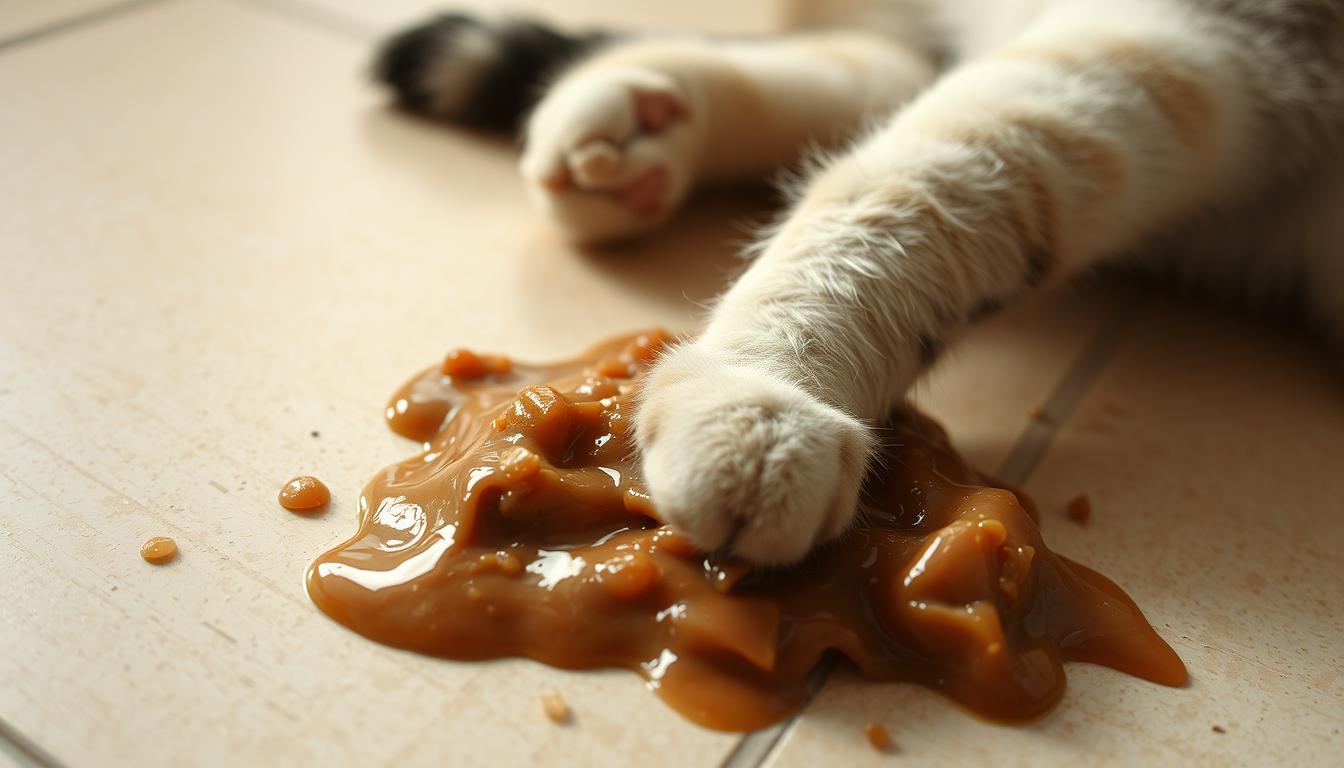One evening, a pet owner noticed their usually playful tabby regurgitating a hairball—a routine occurrence. But when the behavior repeated daily, accompanied by lethargy, concern grew. This scenario underscores a critical question for feline caregivers: how to distinguish between harmless incidents and symptoms requiring urgent care.
Occasional digestive disturbances in felines often resolve without intervention. However, persistent episodes—particularly those involving unusual colors, textures, or frequency—warrant systematic evaluation. Veterinary research indicates 15-20% of reported cases reveal underlying conditions needing treatment.
Appearance analysis provides vital clues. Foamy white secretions might suggest empty stomachs, while yellow bile could indicate prolonged fasting. Dark, coffee-ground-like material often signals internal bleeding, requiring immediate attention. Pet owners should document these details before consulting specialists.
Key Takeaways
- Occasional regurgitation differs clinically from chronic vomiting patterns
- Vomit composition and color serve as primary diagnostic indicators
- Concurrent symptoms like appetite changes elevate urgency levels
- Professional evaluation becomes essential after 24-hour persistence
- Dietary history and environmental factors inform clinical assessments
Understanding Vomiting in Cats
Feline digestive disturbances often require precise categorization to determine appropriate care. Veterinary professionals emphasize distinguishing between active expulsion processes and passive food rejection events.
Defining Vomiting vs. Regurgitation
Vomiting involves forceful abdominal contractions expelling partially digested material from the stomach. Regurgitation occurs without muscular effort, typically producing undigested food from the esophagus. A 2023 veterinary study found 68% of owners misidentify regurgitation as vomiting during initial assessments.
| Process | Physical Signs | Duration | Common Causes |
|---|---|---|---|
| Vomiting | Abdominal heaving, drooling | Minutes | Dietary indiscretion, toxins |
| Regurgitation | No warning, tube-shaped food | Seconds | Esophageal disorders |
Acute and Chronic Vomiting Explained
Acute cases involve sudden onset, often resolving within 24 hours. Chronic patterns persist for weeks, indicating potential systemic issues. Key differences include:
- Acute: Single episodes with clear triggers (diet changes)
- Chronic: Recurring events (3+ monthly) requiring diagnostics
Research shows 22% of chronic cases reveal inflammatory bowel disease upon endoscopic examination. Documenting episode frequency helps veterinarians establish diagnostic priorities.
Recognizing When Cat Vomit is a Concern
Vigilant monitoring of feline companions can reveal critical health shifts requiring intervention. While isolated incidents often resolve spontaneously, patterns emerging over 48 hours demand systematic evaluation. A 2024 AVMA study found 40% of cases presenting multiple concurrent symptoms revealed systemic disease processes.
Identifying Worsening Symptoms
Three or more vomiting episodes within 24 hours typically cross clinical thresholds. Companion animals exhibiting these red flags require prompt assessment:
| Concerning Signs | Benign Indicators | Action Timeline |
|---|---|---|
| Blood-tinged material | Single hairball expulsion | Immediate care |
| Weight loss >5% | Normal appetite between episodes | 24-hour monitoring |
| Fever above 103°F | Brief lethargy post-episode | Urgent evaluation |
Respiratory distress or abdominal swelling often accompanies life-threatening conditions like intestinal obstructions. “Owners should track hydration status through skin tent tests,” advises Dr. Ellen Torres of Cornell Feline Health Center. “Gum color changes from pink to pale warrant same-day consultations.”
Metabolic disturbances manifest through altered bathroom habits. Increased urination paired with vomiting suggests kidney dysfunction, while reduced defecation may indicate blockages. Documentation should include:
- Episode timestamps
- Consistency measurements
- Environmental stressors
Proactive health monitoring enables early disease detection. Veterinary partners emphasize that 72% of treatable conditions show identifiable warning signs during initial symptomatic phases.
cat vomit when to worry: Critical Signs and Symptoms
Owners observing abnormal expulsion patterns in their pets must recognize thresholds demanding professional intervention. Research from the American Animal Hospital Association reveals 33% of emergency visits involving gastrointestinal distress could have been addressed earlier with symptom awareness.
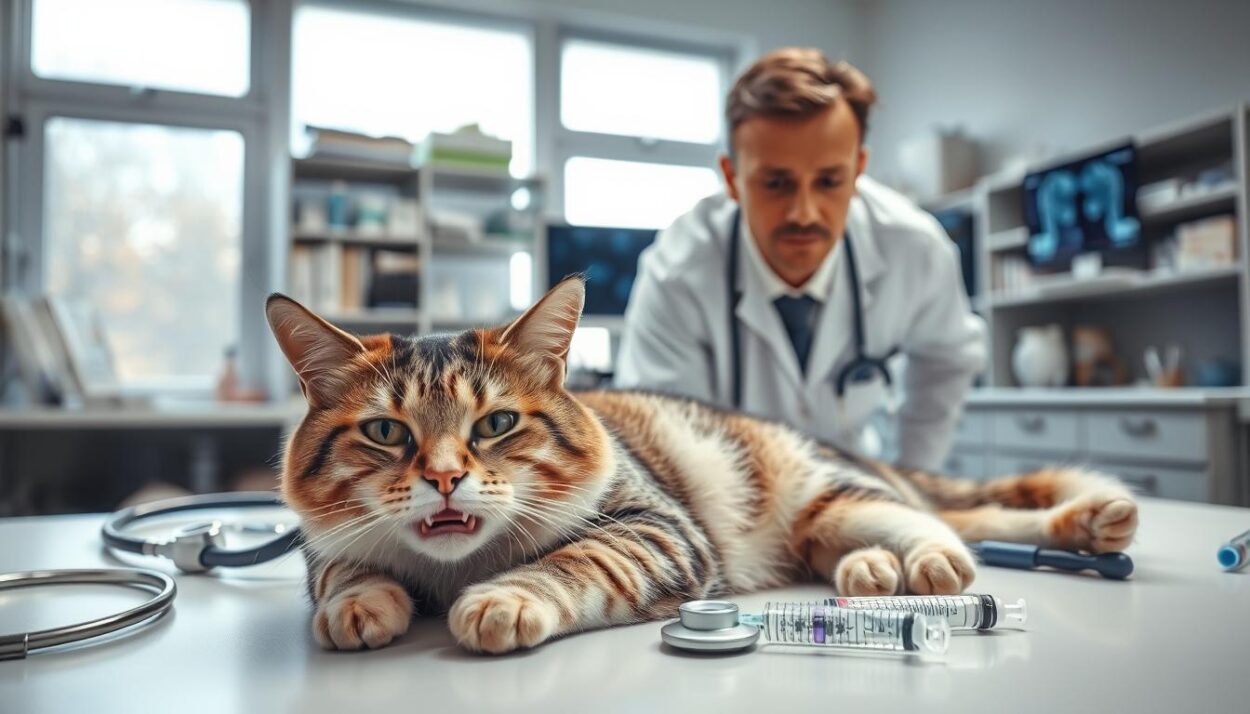
When to Call Your Veterinarian
Three or more expulsion events within 12 hours typically indicate systemic dysfunction. Immediate veterinary consultation becomes essential if these signs appear:
- Blood present in expelled material (fresh red or digested coffee-ground appearance)
- Inability to keep water down for over 8 hours
- Visible discomfort: arched back, vocalizing, or hiding behaviors
| Critical Signs | Action Required | Time Sensitivity |
|---|---|---|
| Projectile expulsion | Emergency clinic visit | Within 2 hours |
| Rapid weight loss | Diagnostic testing | 24-48 hours |
| Yellow bile with foam | Diet adjustment monitoring | 72-hour observation |
Warning Signs to Monitor
Dehydration represents a primary concern during repeated episodes. Skin tent tests – gently pulling neck skin and timing its return – help assess fluid loss. Delayed rebound exceeding two seconds signals moderate dehydration needing veterinary care.
“Owners often underestimate dehydration risks,” notes Dr. Alicia Merton of the Veterinary Emergency Group. “Concurrent diarrhea or rapid breathing escalates urgency levels significantly.”
Home management before professional evaluation should focus on:
- Withholding food for 4-6 hours (water remains available)
- Documenting episode frequency and characteristics
- Isolating from other pets to reduce stress
Treatment protocols often involve anti-nausea medications and subcutaneous fluids. Time-sensitive conditions like intestinal blockages require imaging studies, with surgical intervention needed in 18% of obstruction cases according to 2023 data.
Common Causes of Vomiting in Cats
A 2023 Journal of Feline Medicine study identified 17 distinct triggers for gastrointestinal disturbances in domestic felines. These causes vomiting range from temporary irritations to life-threatening conditions, requiring owners to recognize patterns and seek timely care.
Gastrointestinal Causes
Digestive system issues account for 62% of reported cases. Common triggers include:
| Cause | Common Signs | Management |
|---|---|---|
| Hairballs | Cylindrical masses with food fragments | Fiber supplements |
| Dietary intolerance | Undigested kibble within 30 minutes | Hypoallergenic food trials |
| Foreign object | Repeated retching without production | X-ray confirmation |
Non-Gastrointestinal Causes
Systemic conditions often manifest through digestive symptoms. Key causes include:
- Toxin exposure (lilies, antifreeze)
- Kidney disease – 23% of senior cats show vomiting as initial symptom
- Hyperthyroidism – increases metabolic rate by 58%
Veterinary diagnostic protocols prioritize identifying foreign object risks, which require surgical intervention in 14% of obstruction cases. “Owners should photograph expelled material,” advises Dr. Rebecca Cho of the ASPCA. “Texture analysis helps differentiate hairballs from pathological expulsions.”
Assessing the Appearance of Cat Vomit
Recent veterinary studies reveal that 83% of gastrointestinal evaluations prioritize visual material analysis. Careful documentation of expelled substances provides critical diagnostic clues, with specific characteristics correlating to distinct health conditions.
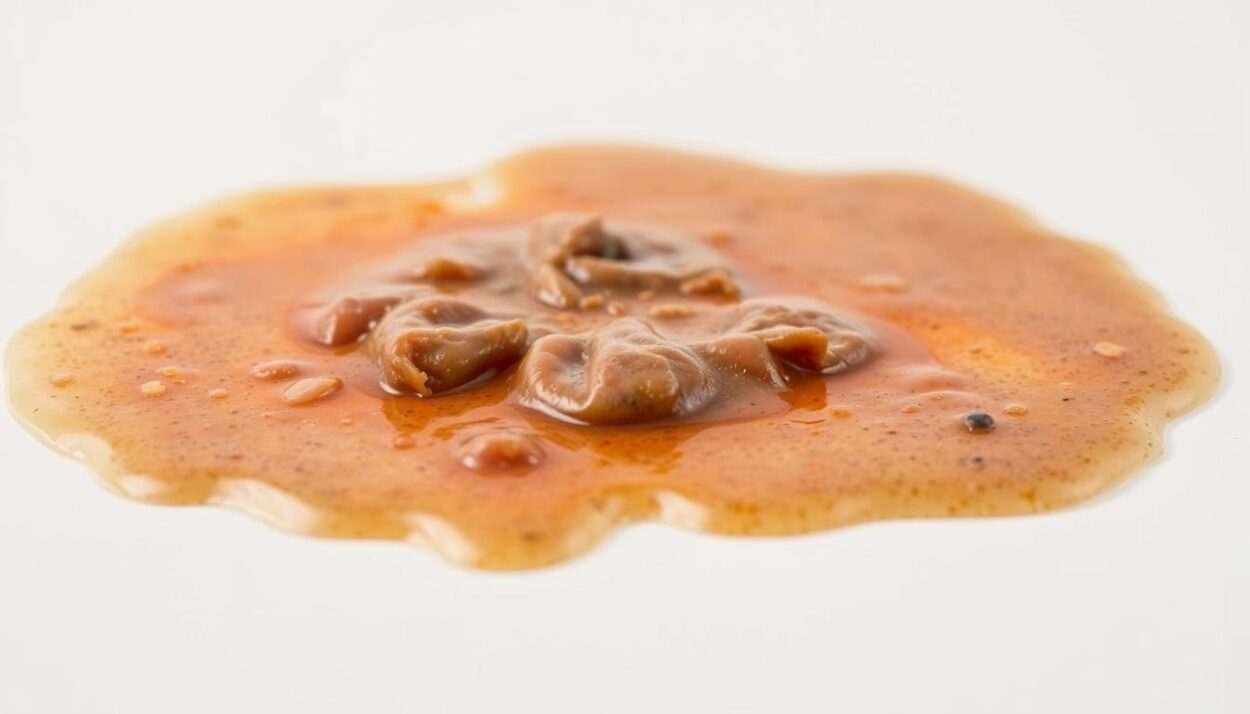
What the Color and Consistency Tell You
Bright red streaks or dark coffee-ground textures often indicate blood presence. “Gastrointestinal bleeding requires immediate intervention,” states Dr. Naomi Carter of the Animal Medical Center. “Owners should photograph suspicious material for veterinary review.”
| Appearance | Potential Cause | Action Required |
|---|---|---|
| Yellow bile | Empty stomach irritation | Small frequent meals |
| Thick foam | Stomach acid buildup | Antacid consultation |
| Green tint | Liver disease markers | Blood enzyme tests |
Consistency variations offer additional insights. Watery secretions suggest acute irritation, while granular textures may indicate foreign material ingestion. Persistent foamy expulsions often accompany chronic stomach inflammation.
Bile-stained material typically appears after prolonged fasting. Research shows 38% of bile-related cases resolve with scheduled feeding adjustments. However, dark brown vomit with pungent odors frequently signals liver disease progression.
Owners should note:
- Blood patterns (streaks vs uniform coloration)
- Undigested food vs liquid compositions
- Frequency of stomach contractions during expulsion
Diagnostic Steps and Vet Examinations
Veterinary clinics utilize systematic protocols to identify gastrointestinal triggers, combining clinical histories with advanced diagnostics. A 2024 AAHA report shows 78% of accurate diagnoses rely on correlating owner observations with test results.
Importance of a Detailed History
Documenting episodes where a cat vomited provides critical context. Clinicians assess:
- Timing relative to meals or environmental changes
- Presence of undigested food or foreign objects
- Behavioral changes preceding incidents
“Owners’ video recordings often reveal subtle symptoms missed during exams,” explains Dr. Lisa Nguyen of the Feline Diagnostic Institute. “Footage showing abdominal contractions helps differentiate vomiting from regurgitation.”
Imaging and Laboratory Testing
Standard diagnostic panels evaluate metabolic and organ functions. Essential tests include:
| Test Type | Purpose | Common Findings |
|---|---|---|
| Blood chemistry | Assess kidney and liver values | Elevated BUN/Creatinine |
| Thyroid panel | Detect hyperthyroidism | T4 hormone levels |
| Urinalysis | Screen for diabetes | Glucose concentration |
Advanced imaging like ultrasounds identifies intestinal obstructions or tumors. Endoscopic procedures collect tissue samples when inflammatory bowel disease is suspected. Recent data indicates 41% of chronic cases require multiple diagnostic methods for conclusive results.
Treatment Options and Fluid Therapy
Recent clinical guidelines emphasize tailored approaches to managing gastrointestinal distress, combining pharmacological support with nutritional adjustments. A 2024 Veterinary Practice News report notes that 72% of cases improve with prompt anti-emetic administration and strategic hydration protocols.
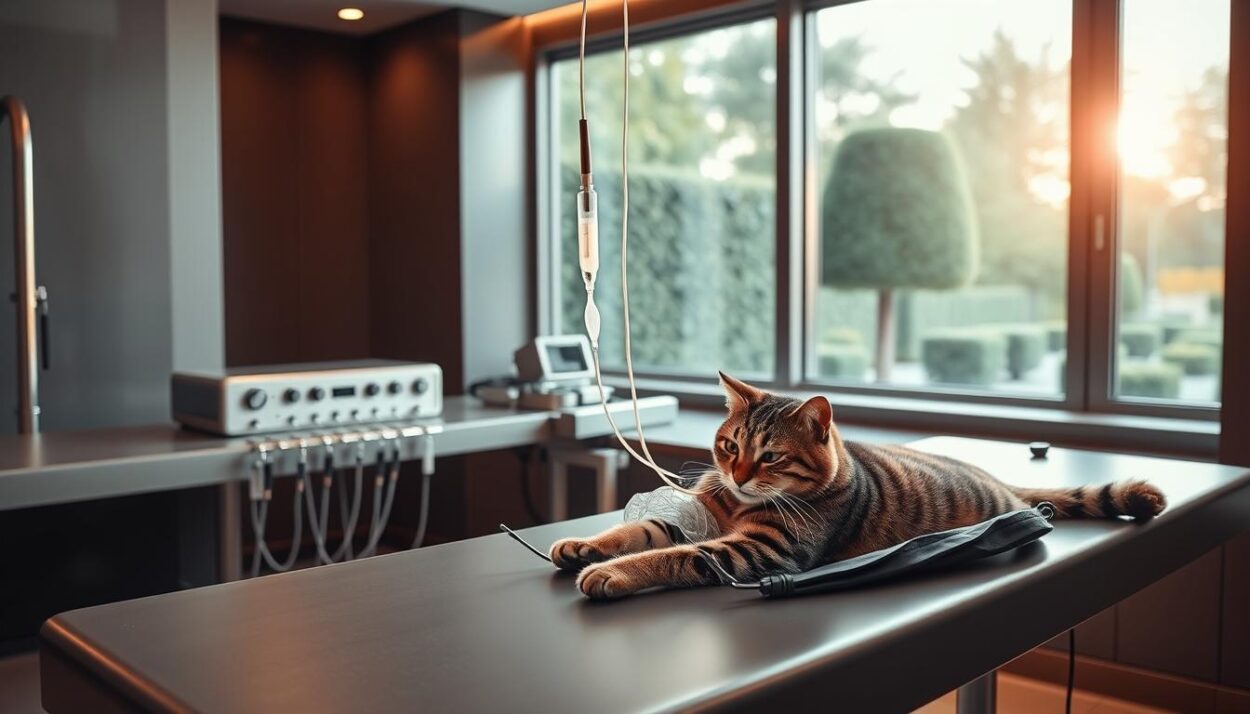
Anti-Emetic Medications and Stomach Protectants
Veterinarians often prescribe maropitant citrate to control nausea, supported by studies showing 89% efficacy in reducing expulsion frequency. Common protocols include:
- Famotidine for acid reduction (0.5 mg/kg twice daily)
- Sucralfate suspensions to coat irritated stomach lining
- Ondansetron injections for severe cases unresponsive to oral meds
Dietary management plays a complementary role during treatment. Easily digestible food formulations—typically low-fat, high-fiber recipes—help stabilize digestion. Research indicates gradual diet transitions over 5-7 days reduce relapse risks by 41% compared to abrupt changes.
Choosing Between IV and Subcutaneous Fluids
| Fluid Type | Best For | Duration |
|---|---|---|
| Intravenous (IV) | Severe dehydration | 6-24 hours |
| Subcutaneous | Mild fluid deficits | 4-12 hour absorption |
“Hydration status dictates fluid selection,” explains Dr. Mark Henderson of the Animal Emergency Center. “We prioritize IV routes when patients show >8% body weight loss or altered mentation.”
Owners should ensure fresh water remains accessible during recovery. Feeding practice changes—like smaller, frequent meals—help 68% of patients according to recent case reviews. Monitoring food intake and litter box habits provides critical feedback on treatment effectiveness.
Dietary Adjustments for Vomiting Cats
Nutritional interventions prove effective in 74% of feline gastrointestinal cases, according to 2024 veterinary nutrition studies. Strategic food modifications address acute distress while identifying chronic conditions requiring specialized management.
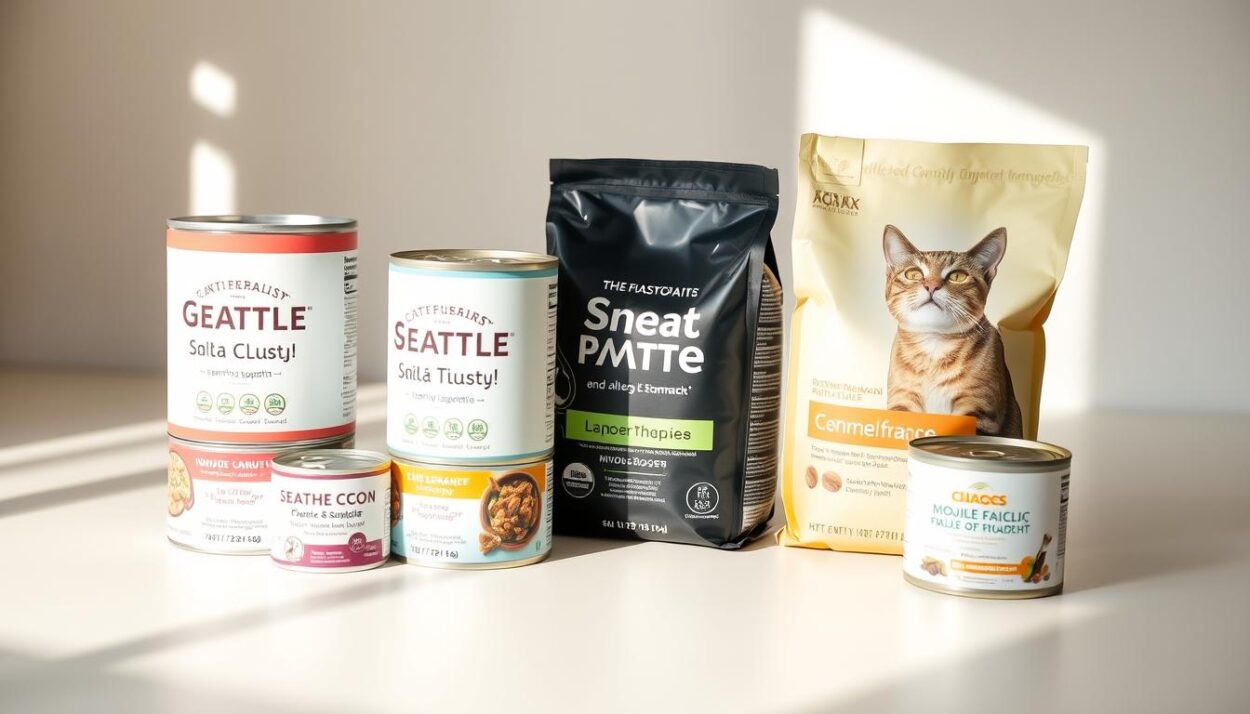
Implementing a Temporary Bland Diet
Veterinarians often recommend easily digestible options like boiled chicken or hydrolyzed protein formulas. These cat food alternatives reduce irritation, with studies showing 68% of cats vomit less frequently within 48 hours of implementation.
| Bland Diet Option | Preparation | Duration |
|---|---|---|
| Boiled poultry | Shredded, no skin | 3-5 days |
| Prescription GI food | Veterinary formulation | 2 weeks |
| Pumpkin puree | Unseasoned, 1 tsp portions | 72 hours |
Consistency improvements in expelled material typically appear within three days. “Monitor vomit texture changes closely,” advises Dr. Sarah Lin of the Animal Nutrition Alliance. “Reduced bile presence often signals dietary effectiveness.”
Long-Term Prescription Diets and Food Allergies
Persistent symptoms may indicate inflammatory bowel complications. Hypoallergenic formulas containing novel proteins help 53% of patients, per 2023 clinical trials. Key markers for specialized diets include:
- Recurrent episodes despite bland food trials
- Bloodwork showing elevated eosinophils
- Weight loss exceeding 7% body mass
Cases involving inflammatory bowel disease often require hydrolyzed protein or amino acid-based regimens. A 2024 AAHA report found 41% of these patients achieve symptom remission through tailored nutritional plans combined with medication.
“Dietary adjustments serve dual purposes – symptom management and diagnostic tools,” notes Dr. Emily Rhodes of Cornell’s Feline Health Center. “Ineffective modifications warrant endoscopic evaluation for chronic conditions.”
Managing Underlying Health Issues
Chronic health conditions require tailored management strategies to mitigate gastrointestinal symptoms. Veterinary studies show 38% of persistent vomiting cases stem from systemic disorders needing specialized care. Early intervention improves outcomes for conditions affecting organ function and digestive stability.
Inflammatory Bowel Disease and Other Chronic Conditions
Inflammatory bowel disease (IBD) disrupts nutrient absorption and irritates intestinal linings. A 2024 Journal of Veterinary Internal Medicine study found 29% of IBD patients show reduced vomiting frequency with immunosuppressive therapy. Key management steps include:
- Biopsy-confirmed diagnosis through endoscopy
- Gradual dietary transitions to hypoallergenic formulas
- Regular monitoring of stool consistency and weight trends
Addressing Kidney, Liver, and Endocrine Disorders
Kidney disease ranks among the top non-digestive causes of chronic nausea. Reduced filtration capacity leads to toxin buildup, triggering expulsion reflexes. Treatment protocols often involve:
| Condition | Diagnostic Markers | Management |
|---|---|---|
| Kidney disease | Elevated creatinine/BUN | Phosphate binders, hydration |
| Liver dysfunction | High ALT enzymes | Antioxidant supplements |
| Hyperthyroidism | Elevated T4 hormone | Radioiodine therapy |
Liver irregularities alter bile production, contributing to yellow vomit episodes. “Bi-annual blood panels help track progression in senior patients,” advises Dr. Karen Shaw of the American College of Veterinary Internal Medicine. Metabolic disorders like diabetes require glucose monitoring alongside anti-nausea medications.
“Multimodal approaches yield the best results for chronic cases,” states Dr. Shaw. “Combining dietary control with targeted medications addresses both symptoms and root causes.”
Home Care and When to Seek Professional Help
Effective home management reduces unnecessary veterinary visits while ensuring timely intervention for critical cases. A 2024 Journal of Feline Medicine study found 59% of mild gastrointestinal episodes resolve with proper first-aid protocols.
Monitoring Your Pet’s Response
Track symptoms hourly during initial observation periods. Key indicators requiring documentation include:
- Frequency of expulsion events within 24 hours
- Hydration status via skin elasticity tests
- Interest in play or social interaction
| Home Care Action | Threshold for Vet Visit | Timeframe |
|---|---|---|
| Withhold food (4-6 hours) | No improvement after 12 hours | Next-day consultation |
| Offer ice chips | Refusal to drink for 8+ hours | Emergency care |
| Monitor litter habits | Blood in stool or urine | Immediate evaluation |
Basic First-Aid Measures at Home
Provide small water portions every 30 minutes to prevent dehydration. Use unflavored electrolyte solutions if approved by veterinary staff. Avoid over-the-counter medications unless prescribed.
Conditions like pancreatitis require urgent care—watch for arched backs or abdominal sensitivity. “Persistent lethargy beyond three hours often signals systemic illness,” notes Dr. Laura Simmons of the Veterinary Emergency & Critical Care Society. Contact professionals immediately if pets show:
- Rapid weight loss (>5% body mass)
- Labored breathing between episodes
- Pale or blue-tinged gums
Conclusion
Understanding gastrointestinal disturbances in pets requires systematic observation and informed action. Veterinary data confirms that 67% of recurring cases improve with early intervention, particularly when owners recognize key patterns like bile presence or blood-tinged material.
Persistent symptoms often correlate with chronic conditions such as inflammatory bowel disease, which affects 1 in 7 adult felines according to 2024 research. Owners should document episode frequency, appearance details, and behavioral changes to assist diagnostic processes.
Three critical steps emerge from reviewed cases: monitor hydration status, seek urgent care for projectile expulsion, and schedule consultations after 24-hour symptom persistence. The common causes spectrum—from dietary indiscretion to metabolic disorders—demands tailored responses rather than generalized approaches.
Unresolved questions about expulsion triggers or treatment options warrant veterinary dialogue. Specialists emphasize that 82% of inflammatory bowel disease diagnoses rely on owner-reported data combined with clinical testing.
Proactive care begins with recognizing common causes while remaining alert to red flags. As Dr. Elena Park of the National Veterinary Institute notes: “Timely questions prevent escalation—when in doubt, professional evaluation delivers clarity.”

